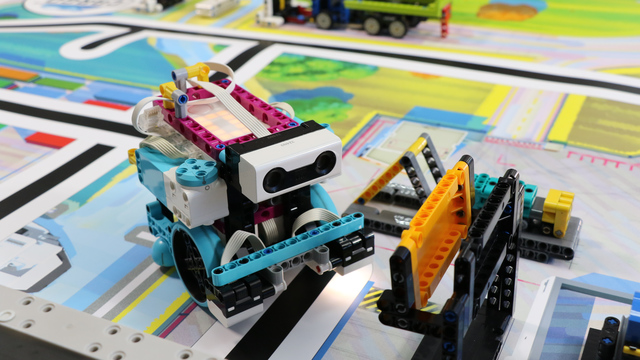This is a 10 out of 10 tutorial for pushing gently on a mission model. We also discuss how to build robots that tolerate error and auto-correct their behavior.
- #2071
- 03 Jan 2023
- 4:14
- LEGO Education SPIKE Prime
- Align, Push, 10 out of 10, FIRST LEGO League, FIRST LEGO League 2021-2022 Cargo Connect, Robot Base Chassis, Attachments, Scratch, LEGO Education SPIKE App Word Blocks 2, Ultrasonic Sensor, Sensors
Auto-correct
The robot will make a mistake. That's for sure. What we can do is develop the program in such a way that it auto-corrects and tolerates the error. The error comes from the physical world. In the program, we can account for the errors and compensate for them.
English
In this video tutorial we do a ten out of ten recording for a very interesting mission - how do we push on the accident avoidance mission model? And as you saw, we must push very slightly. And we use this video as an opportunity to discuss how do we build robots that compensate for the error. Let's start with robot. And we start from a random position. That we've decided to be on this black line. The robot moves forward, it aligns to the border, then goes to the mission model and ever slightly pushes it. And in this way we avoid the accident. We use the LEGO Education SPIKE Prime ultrasonic sensor. With the second run, you saw how the robot moves slightly to the left. But even because even though it makes this error, it still manages to accomplish the mission. We can even start the robot from a different position. We can start the robot to the left or to the right. And even when we do, we still manage to accomplish the mission. How do we do this? This was the third run successful. Now we started from a different position to the right. We managed to accomplish this because we use sensors and we do an error correction. We auto correct the robot. If robot makes a mistake, if there is a small error, it will autocorrect how it goes and it aligns to the border of the competition field. It doesn't matter where the robot starts from, it always aligns to the border. And as it aligns to the border, it turns left to its left. It's right on the recording, but it turns to the left and then it goes to the mission model. And because it uses the sensor, it doesn't matter where it is, it always goes directly to the mission model and stops at about a centimeter after it. And this is a very common principle. It's a very common technique. Now let's start it from further away from us. The robot still moves, aligns the border and then goes to the mission model. And this is one of the basic principles of how do you build consistent and reliable robots? These are robots that align and correct. You see, this front will start it at an angle. It moves at an angle to the border and again it accomplishes the mission.
Now, let's start it from an even stranger position. You see how much of a margin of an error there is for when starting the robot.
As a rule of thumb, as a principle for building consistent and reliable, robots always try to align borders to line and to compensate for the error. And this here is just one of the examples of how you compensate for the error that the robot is making. And the robot will always make an error. It will always make a mistake, but we have to learn how to compensate. See you in the next tutorial.
Courses and lessons with this Tutorial
This Tutorial is used in the following courses and lessons

FIRST LEGO League 2021-2022 Cargo Connect solutions and review with LEGO Education SPIKE Prime
In this course, we demonstrate and explain example solutions for the FIRST LEGO League 2021-2022 Cargo Connect competition. Just like every year, we share solutions only after the season is over. In this course, you will find examples and principles of building attachments and will learn how to program consistent and reliable robots for each mission. You can follow the course, and as you go through each mission, try to replicate the solutions to understand the programs and explanations. Upon completion of the course, you will have many new ideas about how to approach the missions in every FLL robotics competition and how to help your team score more points.
Before starting this course, we suggest you go through the FIRST LEGO League robot game guide
- 55
- 181:18
- 34

M06. Accident Avoidance
In this video tutorial, we demonstrate how to gently push an object to accomplish the mission. "Gently" means that we are pushing but not with force. If we push using force, the mission model will fall, and we will not accomplish the mission. We use LEGO Education SPIKE Prime and the Ultrasonic Sensor.
- 4
- 1
- 2
- 3d_rotation 4